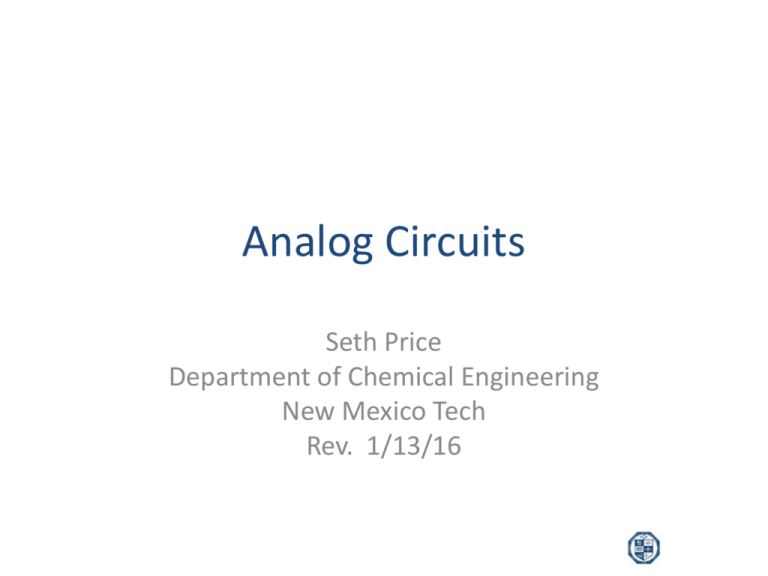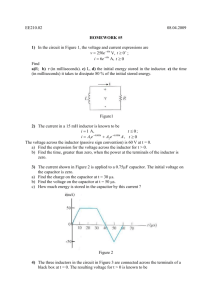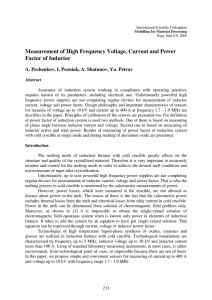Analog Circuits - New Mexico Tech
advertisement

Analog Circuits Seth Price Department of Chemical Engineering New Mexico Tech Rev. 1/13/16 Ohm’s Law • E = IR –E is the voltage across a component –I is the current through a component –R is the resistance of the component Resistor Color Code Series/ Parallel Combinations • Series: the same current passed through multiple components • Req = R1 + R2 + … • Parallel: the same voltage is across multiple components • 1/Req = 1/R1 + 1/R2 + …. Kirchoff’s Current Law (KCL) • Any current flowing into a node must also leave the node: – The sum of all currents = 0 – Think “conservation of mass” Kirchoff’s Voltage Law (KVL) • The sum of the voltages around any closed loop must equal zero – Any voltage generated must be dissipated – Think “conservation of mass” Using a Multimeter • Measure voltage in parallel – Meter tries to have infinite impedance • Measure current in series – Meter tries to have no impedance • 3 Point Safety Check – Measure known voltage (ex wall outlet) – Measure voltage on what you think has no power – Measure known voltage again Current Limiter • All devices have a maximum allowable current • A resistor in series drops current in loop http://tinkerlog.com/2009/04/05/driving-an-led-with-or-without-a-resistor/ Shunt Resistor • High currents are hard to measure • Instead, place a small resistance (of known value) in series • Measure voltage drop across resistor • From Ohm’s law: I= V/R http://www.reuk.co.uk/What-is-a-Shunt.htm Wheatstone Bridge • Easy to detect small voltages • R1, R2 and R3 are known • Rx is adjustable – Perhaps a sensor • As Rx changes, the current from A->C changes, Vg changes http://en.wikipedia.org/wiki/Wheatstone_bridge Diodes (PN Junction) • • • • Diodes conduct in only one direction Semiconducting device Resistance is non-linear Require a “knee” or “turn-on” voltage – Silicon: 0.6-0.7V – Germanium: 0.3V – LED: 1.7V Diode Vs. Sine Wave • http://www.duncansonelectric.com/blog/wpcontent/uploads/2009/08/23-half-wave-rectifier-1024x368.gif IV Curve for Diodes https://learn.sparkfun.com/tutorials/diodes/real-diode-characteristics Capacitors • Store energy in an electric field • Measured in Farads (F) • Two physical configurations – Parallel plates – Concentric cylinders Capacitor Combinations • Series Combination: • 1/Ceq = 1/C1 + 1/C2 + … + 1/Cn • Parallel Combination: • Ceq = C1 + C2 + … + Cn Capacitor Voltage Vc(t) = Vs(1-e-t/T) • Vc(t): Voltage across capacitor at any time • Vs: Source voltage • T: Time constant • t: elapsed time Inductors • Store energy in a magnetic field • Measured in Henries (H) • Typically a coil of wire • Adjustable inductor: slug Inductor Combinations • Series Combinations • Leq = L1 + L2 + … + Ln • Parallel Combinations • 1/Leq = 1/L1 + 1/L2 + … + 1/Ln Inductor Voltage V(t) = -L * di/dt • V(t): Voltage across Inductor as a function of time • L: inductance in Henries • di/dt: change in current with respect to time Time Constants • Time Constant (T): way to characterize time to charge/discharge a capacitor or inductor • 1*T: 63% of the maximum charge • 5*T: fully charged • For a capacitor: T = R*C • For an inductor: T = L/R Solenoids • Changing current induces magnetic field • Magnetic field moves plunger • Used in starter motors, valves, latches, etc. Solenoid Valve Transformers • Two adjacent inductors that can influence each other • Can add an iron core to transformer to increase magnetic field • No electron travels between inductors – Isolation Transformer Putting it all together… • DC Power Supply








